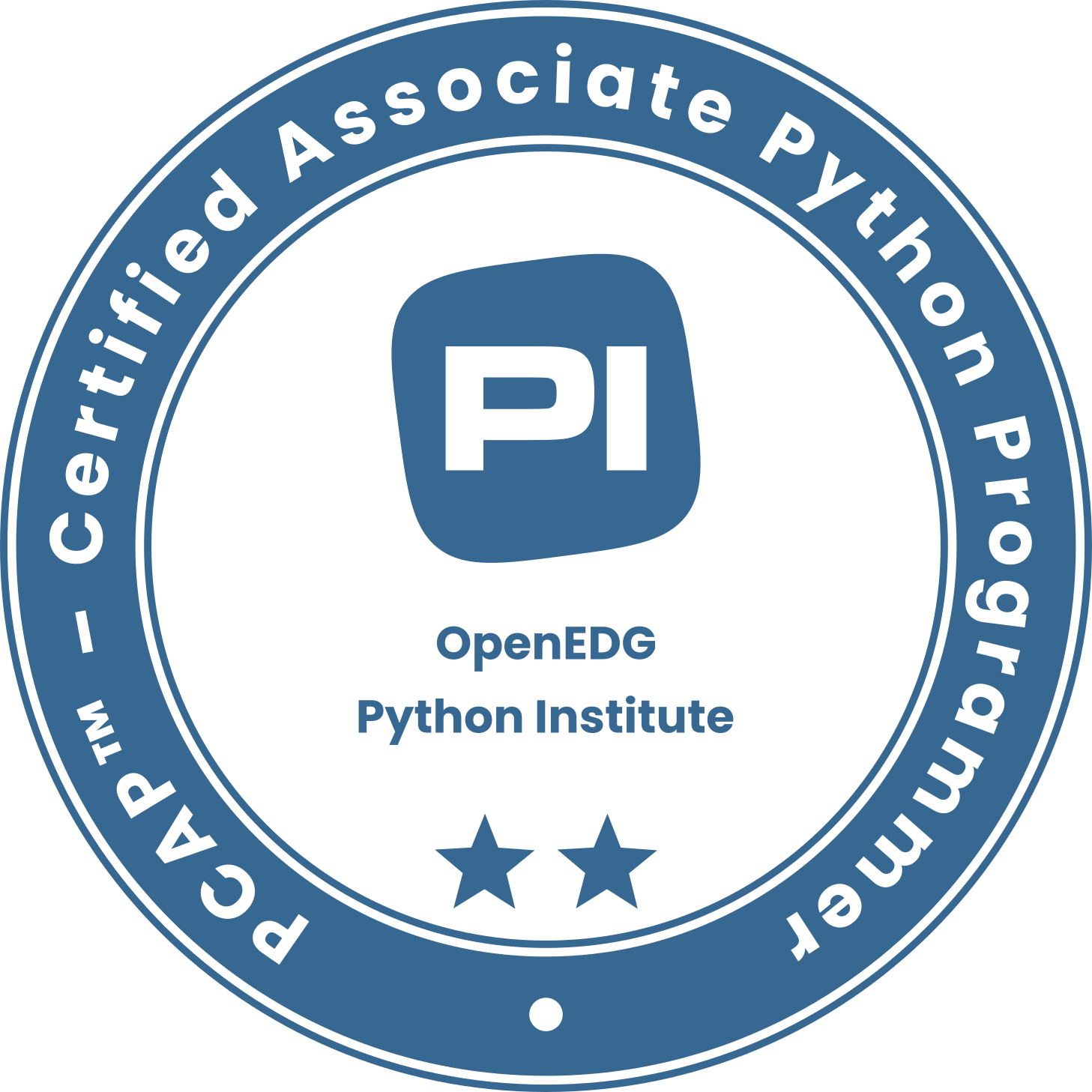PCAP

| Formats: | Asynchronous |
| Blended | |
| Online | |
| Onsite | |
| Part-time | |
| Level: | Beginner |
| Prerequisites: | |
| Recommended Knowledge | |
| Basic Knowledge of Python | |
Formats: We offer our training content in a flexible format to suit your needs. Contact Us if you wish to know if we can accommodate your unique requirements.
Level: We are happy to customize course content to suit your skill level and learning goals. Contact us for a customized learning path.
Certified Associate in Python Programming (PCAP)
Our Certified Associate in Python Programming (PCAP) training course builds on the foundational knowledge acquired in the Python Fundamentals training for the Certified Python Entry-Level Programmer. This course expands on the basics of functions, flow control, and sequences, providing a solid foundation for mastering object-oriented programming in Python. The curriculum covers essential topics, including control and evaluations, data aggregates, functions and modules, and classes, objects, and exceptions. By delving deeper into these areas, students will enhance their Python skills and prepare for more advanced programming challenges.
Target Audience
The PCAP training course is designed for individuals who have completed the PCEP certification or possess equivalent knowledge and skills in Python programming. It is ideal for aspiring software developers, data analysts, system administrators, and anyone looking to advance their Python programming capabilities. This course is particularly beneficial for those aiming to obtain the PCAP certification, as it comprehensively covers all necessary topics. Participants should have a basic understanding of Python programming concepts and be comfortable with fundamental programming structures and operations.
Job Opportunities
Completing the PCAP training opens up numerous job opportunities in various sectors that rely on Python programming. Graduates can pursue roles such as Python Developer, Data Analyst, Software Engineer, and DevOps Engineer. The advanced skills and knowledge gained from this course are highly valuable in fields such as web development, data science, automation, and artificial intelligence. Additionally, the PCAP certification serves as a stepping stone for further Python certifications and advanced career opportunities, validating your expertise and enhancing your employability in the tech industry.
PCAP | Certified Associate in Python Programming course objectives
- Control and Evaluations
- basic concepts: interpreting and the interpreter, compilation and the compiler, language elements, lexis, syntax and semantics, Python keywords, instructions, indenting
- literals: Boolean, integer, floating-point numbers, scientific notation, strings
- operators: unary and binary, priorities and binding
- numeric operators: ** * / % // + –
- bitwise operators: ~ & ^ | << >>
- string operators: * +
- Boolean operators: not and or
- relational operators ( == != > >= < <= ), building complex Boolean expressions
- assignments and shortcut operators
- accuracy of floating-point numbers
- basic input and output: input(), print(), int(), float(), str() functions
- formatting print() output with end= and sep= arguments
- conditional statements: if, if-else, if-elif, if-elif-else
- the pass instruction
- simple lists: constructing vectors, indexing, and slicing, the len() function
- simple strings: constructing, assigning, indexing, slicing comparing, immutability
- building loops: while, for, range(), in, iterating through sequences
- expanding loops: while-else, for-else, nesting loops, and conditional statements
- controlling loop execution: break, continue
- Data Aggregates
- strings in detail: ASCII, UNICODE, UTF-8, immutability, escaping using the \ character, quotes and apostrophes inside strings, multiline strings, copying vs. cloning, advanced slicing, string vs. string, string vs. non-string, basic string methods (upper(), lower(), isxxx(), capitalize(), split(), join(), etc.) and functions (len(), chr(), ord()), escape characters
- lists in detail: indexing, slicing, basic methods (append(), insert(), index()) and functions (len(), sorted(), etc.), del instruction, iterating lists with the for loop, initializing, in and not in operators, list comprehension, copying and cloning
- lists in lists: matrices and cubes
- tuples: indexing, slicing, building, immutability
- tuples vs. lists: similarities and differences, lists inside tuples and tuples inside lists
- dictionaries: building, indexing, adding and removing keys, iterating through dictionaries as well as their keys and values, checking key existence, keys(), items() and values() methods
- Functions and Modules (25%)
- defining and invoking your own functions and generators
- return and yield keywords, returning results, the None keyword, recursion
- parameters vs. arguments, positional keyword and mixed argument passing, default parameter values
- converting generator objects into lists using the list() function
- name scopes, name hiding (shadowing), the global keyword
- lambda functions, defining and using
- map(), filter(), reduce(), reversed(), sorted() functions and the sort() method
- the if operator
- import directives, qualifying entities with module names, initializing modules
- writing and using modules, the __name__ variable
- pyc file creation and usage
- constructing and distributing packages, packages vs. directories, the role of the __init__.py file
- hiding module entities
- Python hashbangs, using multiline strings as module documentation
- Classes, Objects, and Exceptions
- defining your own classes, superclasses, subclasses, inheritance, searching for missing class components, creating objects
- class attributes: class variables and instance variables, defining, adding, and removing attributes, explicit constructor invocation
- class methods: defining and using, the self parameter meaning and usage
- inheritance and overriding, finding class/object components
- single inheritance vs. multiple inheritance
- name mangling
- invoking methods, passing and using the self argument/parameter
- the __init__ method
- the role of the __str__ method
- introspection: __dict__, __name__, __module__, __bases__ properties, examining class/object structure
- writing and using constructors
- hasattr(), type(), issubclass(), isinstance(), super() functions
- using predefined exceptions and defining your own ones
- the try-except-else-finally block, the raise statement, the except-as variant
- exceptions hierarchy, assigning more than one exception to one except branch
- adding your own exceptions to an existing hierarchy
- assertions
- the anatomy of an exception object
- input/output basics: opening files with the open() function, stream objects, binary vs. text files, newline character translation, reading and writing files, bytearray objects
- read(), readinto(), readline(), write(), close() methods